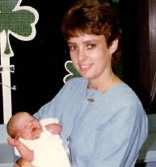

Airway, Breathing, Circulation
Assess consciousness - Try to arouse infant.
Activate emergency response - Have someone call 911 on the telephone; get help!
Open the airway - Tilt the head back gently and lift the chin slightly to ensure infant's airway is open, taking care not to over extend the neck.
Check for breathing - Look, listen and feel for breathing for 3-5 seconds, try to see the chest move, try to hear the infant breathing.
If infant is not breathing:
Begin rescue breathing - Give 2 gentle breaths. Each breath is 1 second.
Cover the infant's nose and mouth with your mouth, and breathe into infant's
mouth and nose at the same time. Watch chest gently rise, this ensures your
breaths are entering the infant's lungs. Be sure to give gentle breaths or
"puffs", taking great care not to over-inflate the infant's lungs.
If there is no chest movement, reposition the infant's head to open the airway,
and repeat the 2 breaths. Make sure there is nothing in infant's mouth blocking
the airway and preventing breathing.
(Instructions on "Choking Victims" available from the "American
Red Cross" and "American Heart Association").
Check for pulse - Use index and middle finger, place these 2 fingers firmly on the inside of infant's arm, about level to the nipples on infant's chest. Feel for a heart beat (pulse) for 5 seconds.
If infant has a pulse:
Continue rescue breathing - Give 1 breath every 3 seconds. After one minute recheck
the pulse to make sure infant still has a heartbeat, check for spontaneous
respiration.
If infant is still not breathing continue rescue breathing. *Do not stop rescue
breathing until emergency technicians arrive and assume care of infant, or
infant begins to breathe spontaneously on own.
If infant has no pulse:
Begin chest compressions - First give 2 gentle breaths, then position your
index and middle fingers on infant's chest, on the sternum (chest bone between
the infant's nipples), one index finger width below the child's nipples, (where
the heart is located) and press down 1/2 to 1 inch. This is 1 chest compression.
You will now give 5 chest compressions, then 1 breath. Give 2 to 3 chest compressions
every second.
Repeat this 5-1 ratio over and over - Give 5 chest compressions, then 1 breath, then again give 5 chest compressions, then 1 breath, etc.
Recheck the infant's pulse - After about 1 minute of CPR, recheck the infant's pulse.
If infant still has no pulse:
Continue CPR as above.
If infant now has a pulse:
Stop chest compressions - Check for spontaneous respiration. If infant now has a pulse (heart beat) but is still not breathing, continue rescue breathing. *Never stop CPR until medical help arrives and assumes care, or infant regains pulse and breathing.
*Everyone needs to know CPR, it can save a life! Contact the "American Heart Association" or the "American Red Cross" for instruction and certification.
Years ago when I created this page my idea was to offer a simple and easy to understand adaptation of infant CPR for those with little or no CPR training. Hopefully some have found it helpful. This adaptation is not meant to take the place of proper CPR training and certification.
Written in 1998.

My first years as a nurse, beginning in 1983, were spent in the Neonatal Intensive Care. It was a very rewarding time for me.